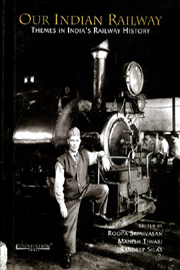Book contents
- Frontmatter
- Contents
- Foreword
- Preface
- Introduction
- 1 The Colonial Context of the Bengal Renaissance: A Note on Early Railway–Thinking in Bengal
- 2 Minute by Dalhousie on Introduction of Railways in India, as Submitted to the Court of Directors, 4 July 1850
- 3 Ackworth Committee Report
- 4 Competition and Adaptation: The Operation of Railways in Northern India: Uttar Pradesh 1860–1914
- 5 Economic Nationalism and the Railway Debate, circa 1880-1905
- 6 Railway Policing and Security in Colonial India, c. 1860–1930
- 7 Indian Nationalism and Railways
- 8 The Railway in Colonial India: Between Ideas and Impacts
- 9 The Dark Side of the Force: Mistakes, Mismanagement and the Malfeasance in Early Railways of the British Indian Empire
- 10 Tunnels and Bridges: Railways, Narrative and Power in two Novels of India
- 11 A View of the History of Indian Railways
- 12 The Romance of Steam
- Index
- Plate section
3 - Ackworth Committee Report
Published online by Cambridge University Press: 26 October 2011
- Frontmatter
- Contents
- Foreword
- Preface
- Introduction
- 1 The Colonial Context of the Bengal Renaissance: A Note on Early Railway–Thinking in Bengal
- 2 Minute by Dalhousie on Introduction of Railways in India, as Submitted to the Court of Directors, 4 July 1850
- 3 Ackworth Committee Report
- 4 Competition and Adaptation: The Operation of Railways in Northern India: Uttar Pradesh 1860–1914
- 5 Economic Nationalism and the Railway Debate, circa 1880-1905
- 6 Railway Policing and Security in Colonial India, c. 1860–1930
- 7 Indian Nationalism and Railways
- 8 The Railway in Colonial India: Between Ideas and Impacts
- 9 The Dark Side of the Force: Mistakes, Mismanagement and the Malfeasance in Early Railways of the British Indian Empire
- 10 Tunnels and Bridges: Railways, Narrative and Power in two Novels of India
- 11 A View of the History of Indian Railways
- 12 The Romance of Steam
- Index
- Plate section
Summary
Unanimous Recommendations
1. We propose great changes in the constitution, status and functions of the Railway Board. We recommend that at the head of the Railway Department there shall be a Member of Council in constant touch with railway affairs; and we suggest that with this object there shall be created a new Department of Communications responsible for railways, ports and inland navigation, road transport (so far as the Central Government deals with this subject) and posts and telegraphs. We think the Member in charge of Communications must be an experienced administrator and able to represent his Department both in the legislature and with the public. We do not think he need be expected to be a technical expert.
2. We recommend that, on the one hand, the reconstituted Railway Department should delegate considerably increased power of day-to-day management to the local railway administrations, and on the other hand should be relieved from control by the India Office and by the Government of India except on large questions of finance and general policy.
3. We recommend that the Finance Department should cease to control the internal finance of the railways; that the railways should have a separate budget of their own, be responsible for earning and expending their own income, and for providing such net revenue as is required to meet the interest on the debt incurred or to be presented to the 42 Our Indian Railway Legislative Assembly, not by the Finance Member of Council, but by the Member in charge of Railways.
- Type
- Chapter
- Information
- Our Indian RailwayThemes in India's Railway History, pp. 41 - 49Publisher: Foundation BooksPrint publication year: 2006
- 1
- Cited by

